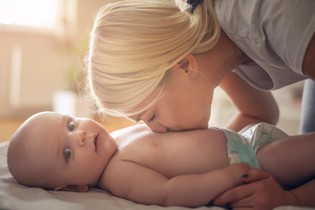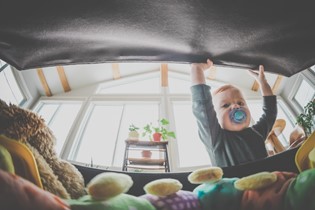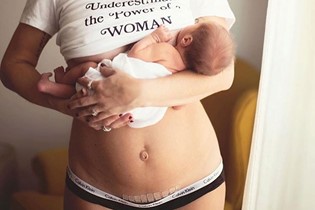How to: yoga with a new baby

If you're looking for a way to exercise and socialise with your newborn baby in tow, follow the advice of yoga instructor Petra Tip, and head to a mums and babies yoga class near you.
For the first few weeks after having your baby, your focus should be on allowing your body to heal and to get to know your newborn. But once you're feeling ready to get out of the house, it'll be nice to head to a place where you can look forward to some gentle exercise, friendly faces and the convenience of taking your baby to a place where nappy changes, feeds and crying are all par for the course. A postnatal yoga class for mums and babies is a great option. The classes are open to everybody, at whatever level of fitness you're at, and no previous yoga experience is necessary. Most importantly, the classes are baby friendly - there is space for feeding, changing nappies, playing, and yes, even crying. Your baby will lie on a blanket in front of you and watch you as you exercise. At some points in the class, the baby will join in as well.
You can start doing mild yoga poses from around six weeks after giving birth and eight weeks after a Caesarean section. Ask your midwife or GP if you are not too sure when you should start.
In most cases you will have stopped bleeding, the uterus will have returned to its original size, and your sexual organs will be able to function normally again. But for some women the recovery might take a few weeks longer, so it's important to listen to your body and not put yourself under undue pressure. The hormone relaxin, which has softened the ligaments, connective tissues and muscles throughout your pregnancy, will remain in your body for up to five months, so you still need to be aware of how to use your body correctly. The joints are still fragile and lower back pain is very common since the abdominal muscles and pelvic floor are still weak after giving birth. Therefore it's best to avoid high-impact activity, which puts tremendous stress on the pelvic floor and abdominal organs.
What to expect
A typical mums and babies yoga class is around an hour long - long enough for you to get some exercise and for the baby to be "patient". With postnatal yoga the focus is on toning and strengthening your muscles, rebalancing and correcting your posture and stabilising your pelvis after carrying a baby for nine months.
Posture is very important in getting you using your muscles again in the right way. The yoga poses will help you lengthen the spine up towards the sky from your crown and down towards the earth from your feet, helping you stay connected and grounded at the same time.
After giving birth your balance will be different and the yoga class is all about re-adjusting your body.
A postnatal yoga class will also focus on conscious breathing, focusing on the rhythm of your breath - bringing it down towards your belly where baby lived for nine months. It's all about taking ownership of the belly again. I find that women have often created a habit of shallow breathing, because in the last few months of pregnancy the baby sits so high it restricts the movement of the diaphragm. Good breathing will give you energy and help you release any anxiety around being a new mum, increasing positive emotions and decreasing negative feelings.
The yoga poses will improve flexibility, creating good circulation, activate your organs so they are able to function well again and bring the body back into alignment. Check out the examples pictured opposite for specific poses and their benefits.
It's really fine to start with a gentle postnatal yoga programme and focus on the whole body rather than only your belly, even though you'll probably feel that this is the part of your body which needs the most work.
Don't be too hard on yourself if you feel that your body is not showing results straight away. It takes nine months for your body to be pregnant, so allow yourself at least nine months for your body to get back to the way you were before.
I would suggest not doing anything on the morning you come to the class but have an easy time at home with baby. Arrive a bit early so you can settle in and maybe feed the baby before class begins.
Most of all enjoy and feel good.

Moving between cow (above left) and cat (above centre) poses is a good way to strengthen your pelvic floor and abdomen. You can then move up into downward-facing dog (above right), and keep your face nice and close to baby for added entertainment.

Standing poses such as the warrior (above left) or tree pose (above right) will help you regain leg strength and endurance, building up stamina which you'll need as a new mum.

Twisting poses will energise your spine and stimulate your abdominal organs.

Pelvic rocking on the floor moving slowly will gently help to strengthen the abdomen and is a good way to incorporate play with baby.
Petra Tip is the founder of Shambala Yoga and mother of four. She is a qualified pre-natal and Hatha Yoga teacher and a Chi Nei Tsang practitioner. She has a special focus on pre and postnatal women, running classes in West Auckland. Petra also runs pregnancy workshops for couples and developmental baby massage courses. For more information contact Petra by email: shambala.nz@gmail.com.
Models: Lesley Turner and 11 week old baby Alex.

AS FEATURED IN ISSUE 17 OF OHbaby! MAGAZINE. CHECK OUT OTHER ARTICLES IN THIS ISSUE BELOW

















